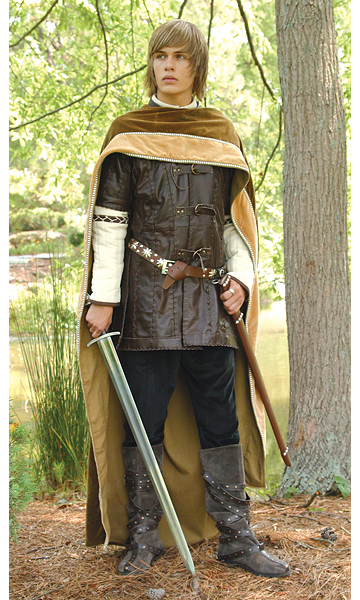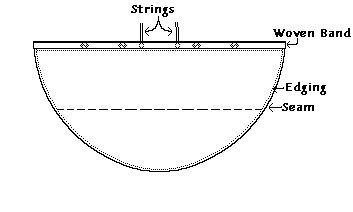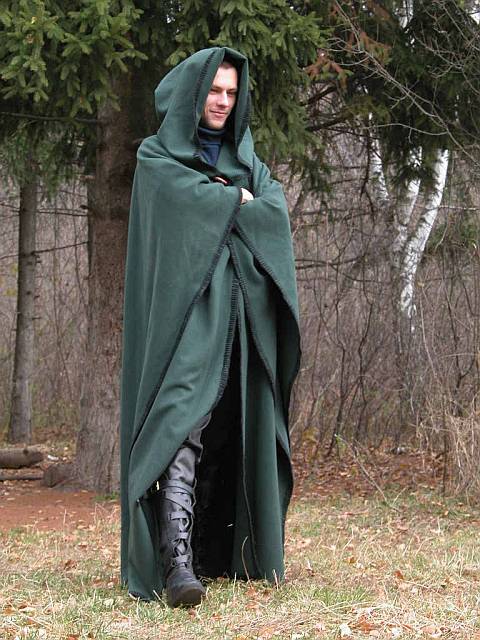Difference between revisions of "Cloak"
m (added category) |
|||
| Line 45: | Line 45: | ||
[[Category:Garb]][[Category:How To]] [[Category:European Garb]] | [[Category:Garb]][[Category:How To]] [[Category:European Garb]] | ||
[[Category:Outerwear]] | [[Category:Outerwear]] | ||
| + | [[Category:Unformatted Resources]] | ||
Revision as of 02:53, 30 March 2016
The English word cloak derives from the medieval Latin cloca, meaning cape, and the Old French cloke, which was the same as the later cloche, meaning bell. The word was used because the most usual form of cloak in the early centuries AD, as well as in more ancient cultures, was a simple bellshaped design without fastening, made from a roughly circular piece of material with a hole cut for the head. The German medieval design Glocke was similarly named.
A loose type of outer covering for the body has remained in use in all parts of the world since man first wore animal skins. Throughout the centuries the piece of fabric, large or small, was utilised by the ordinary man or woman as a blanket or bed-covering at night and a garment by day, its size and material varying only according to the climate in which it was being worn. Examples of this double use of the cloak stem most often from societies where a person had to spend the night in cold weather or in the open and required protection from the rain and wind. Roman soldiers used their cloaks for this purpose, as did the Scots who wrapped themselves in their plaid at night and pleated and draped it round themselves by day. In the Middle East, the Arab burnous and hayk have traditionally served the same purpose as they were essential in the chill of the desert night. The earliest cloaks were simply fur skins held to the body by a leather thong or fastened by a thorn or a crude pin at the shoulder. Later, the cloak became an outer garment worn over a tunic and hose; while in the more sophisticated times of the sixteenth and seventeenth centuries in Europe, this outer garment, still necessary for travelling, riding and keeping out the cold, had become an item of fashion in its own right, with an elegance of line and beauty of fabric and lining.
Types of cloaks
Half Circle is literally a partial circle of fabric. This style does not close well in front. For warmth, chose one of the other styles, like a full circle cloak. The basic pattern calls for a large half-circle for the cloak. Instead of cutting a half-circle or oval in the center of the straight side the way you normally would for a cloak, come in 2-3 inches and then cut a full circle 6 or 7 inches in diameter (depending on the size of your head). Then just stick your head through the hole. That has the right drape.
The Rectangle Style has much fabric gathered into the neck. This is the type of cloak is just a rectangle (fingertip to fingertip, and down to the floor on both sides) with a split up the center and a hood. Folkwear Kinsale Cloak - for experienced sewers (this pattern has a number of advanced techniques).
A Pareo is almost the simplest of capes to make. It is a long length of wool fabric about 70 to 80 inches made from 60 inch wide cloth that is slit and very lightly shaped part way up the centre fold.
This is an item that might get an airing once a year or so when you are seeking a cover up for a difficult to cover evening dress to take you from car to door, but when a pashmina is simply too lightweight. It is also perfect for fancy dress to add a touch of mystery. My sister and I have always jokingly referred to pareos as Zorro capes, and they are dramatic when made in black material.
They would also be ideal as fast to make capes for a drama production. This is because the fabric is preserved in almost its whole state, so the item might be re-cut into another garment for another project at a later date.
Cloak Patterns
- Moroccan burnoose This is a Moroccan burnoose laid flat from Max Tilke. The bottom hem is an exact half circle.
- The Roman sagum and paenula cloaks Vogue 7110 - View A is a full circle cape with hood, rated Very Easy.
- Simplicity 5794 - Full cape with variations.
- Simplicity's 9887 -(Has a wizard hat pattern.)
- McCall's 4378 - sheer cape with full hood - comes with an interesting dress pattern, too.
- McCall's 4698 - cloak with extremely full, gathered front hood - similar to Kinsale cloak but easier.
- Butterick 4030 - flowy cape with moderate hood- rated "fast & easy".
- Butterick 4050 - hooded robe/sleeved cloak (whichever way you want to look at it)
- Butterick 4377 - hooded cloak w/gathered neckline
Links
- how to make an anglo saxon Rectangular cloak
- History of Cloaks
- Wikipedia
- How to make a quick and easy cloak by Vaargard
- Simple cloak PDF Pattern
- by cloaks at Swords of honor
- buy cloaks at Pirate Cave
- Buy Cloaks at Medieval Collectables
- Buy cloaks at Medieval Moonlight
- Frog closures
- Cloak Clasps
- Cloak Clasps


